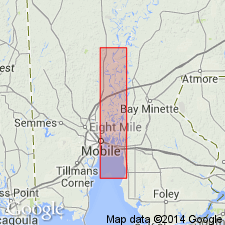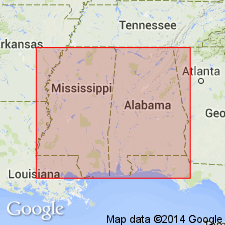
- Usage in publication:
-
- Ecor Rouge Sand
- Modifications:
-
- Named
- Dominant lithology:
-
- Sand
- Gravel
- AAPG geologic province:
-
- Mid-Gulf Coast basin
Summary:
Ecor Rouge Sand named on Mobile Bay, southwestern AL. Unit is composed of white and reddish-brown cross-bedded, fluvial marine clastics: sand, gravelly sand, and quartzite gravel. Thickness is 12 m. Overlies Mobile Clay and underlies Citronelle Formation. Age is late Miocene.
Source: GNU records (USGS DDS-6; Reston GNULEX).

- Usage in publication:
-
- Ecor Rouge Sand
- Modifications:
-
- Overview
- AAPG geologic province:
-
- Mid-Gulf Coast basin
Summary:
Type section at Ecor Rouge is highest point of land on combined Atlantic-Gulf Coasts. Reveals thin laminated clays, ironstones, cross-bedded sands, and gravelly sands. Unit is 12 m thick at type section and 10.5 m thick at exposure on Wolf Ridge Road. Age is late Miocene.
Source: GNU records (USGS DDS-6; Reston GNULEX).
For more information, please contact Nancy Stamm, Geologic Names Committee Secretary.
Asterisk (*) indicates published by U.S. Geological Survey authors.
"No current usage" (†) implies that a name has been abandoned or has fallen into disuse. Former usage and, if known, replacement name given in parentheses ( ).
Slash (/) indicates name conflicts with nomenclatural guidelines (CSN, 1933; ACSN, 1961, 1970; NACSN, 1983, 2005, 2021). May be explained within brackets ([ ]).

